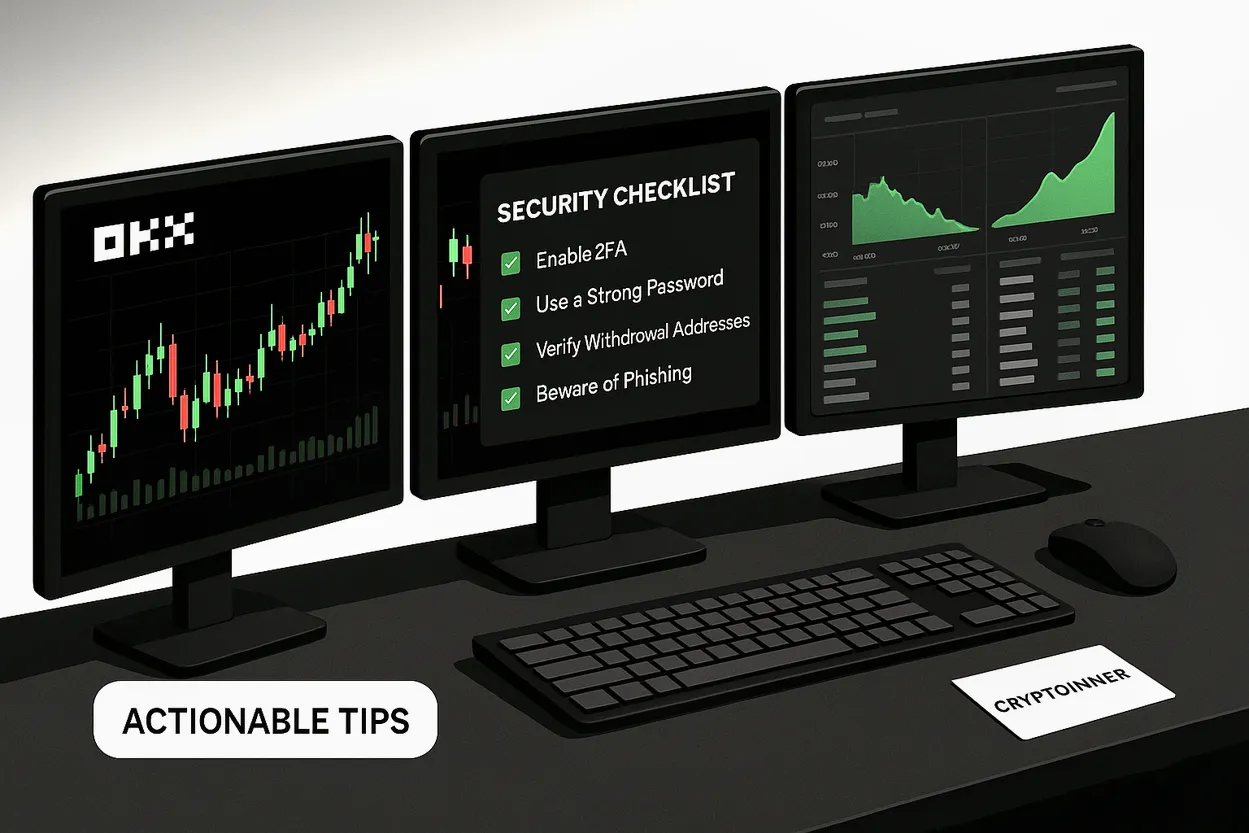If you’re exploring OKX or leveling up your setup, this guide distills practical, field‑tested tactics that make a real difference day to day. From account hardening and fee optimization to smarter order flow, bots, and futures nuance, these Useful tips for OKX aim to help you operate with clarity and control.
Pro tip before we dive in: grab any new‑user perks and fee discounts while they’re available. You can sign up or re-check benefits via this referral link: Join OKX with code CRYPTONEWER. It’s a quick win that compounds over time if you’re active.
Quick-start checklist for OKX
- Create your account and complete KYC for higher limits and smoother fiat ramps
- Secure the account (see security section below) before you deposit anything
- Set currency display, fee mode, and layout preferences in Settings
- Decide your primary market: spot, futures, or Earn products for passive yield
- Bookmark the fee schedule and VIP tiers so you can plan upgrades
- Add the referral benefit if you haven’t yet: OKX signup CRYPTONEWER
Security hardening that actually matters
Security isn’t glamorous, but it’s the foundation. Here are the high‑impact layers to enable on OKX:
- Two-factor authentication done right
- Use an authenticator app or hardware security key instead of SMS
- Store backup codes offline in two separate places
- Anti‑phishing code for emails
- Set a custom code in your account; genuine OKX emails will display it
- Withdrawal whitelist
- Lock withdrawals to addresses you control; add new addresses only during “cold” periods, never mid-volatility
- Device approvals and session reviews
- Regularly prune old devices and sessions; revoke what you don’t recognize
- API key hygiene
- If you use bots or third‑party tools, create scoped API keys with only the permissions you need and IP allowlisting enabled
- Sub‑accounts and role separation
- Keep experimenting or higher‑risk activity in a separate sub-account to isolate blast radius
Treat security like position sizing for your identity. Reduce single points of failure, review logs weekly, and never rush key changes.
Fee optimization and OKB perks
Exchange fees are a persistent drag on returns, especially if you rebalance, run bots, or scalp. Use these to trim costs:
- Prefer maker flow when it suits your strategy
- Limit orders with Post‑Only can qualify as maker and often cost less than taker fills
- Climb tiers intentionally
- Monitor your 30‑day volume and step up tiers when feasible. The fee cut can be meaningful for active traders
- Consider OKB holdings
- Holding OKB can unlock discounted trading fees and other perks. Calculate your breakeven and re-evaluate monthly
- Bundle rebalance events
- Instead of many small taker orders, plan fewer, larger maker orders during deeper liquidity windows
- Compare Convert vs Spot
- Conversions can be fast for simple swaps; for larger size or niche pairs, evaluate spot books and depth to minimize slippage and fees
Pin a simple habit: once a week, check your fee spend and see what portion came from taker fills. A small process change (post‑only, better timing) can save a surprising amount.
Order execution tactics that boost fill quality
Execution matters as much as direction. OKX gives you a toolkit that many traders underuse:
- Post‑Only, IOC, FOK
- Post‑Only ensures maker add‑liquidity behavior; Immediate‑Or‑Cancel (IOC) and Fill‑Or‑Kill (FOK) manage urgency and slippage boundaries
- Reduce‑Only
- For futures, prevent accidental position flips; your close orders won’t open new exposure
- Trigger and Trailing stops
- Place conditional orders that arm only at your chosen trigger; trailing stops ride trends without micro‑management
- OCO (One‑Cancels‑the‑Other)
- Set profit target and stop in one order; the filled leg cancels the other
- Iceberg and TWAP algos
- For size or stealth, split orders to minimize footprint and signaling risk
- Depth‑aware timing
- Look for thicker books near major sessions, events, or index rebalances to improve fill probability
Pro move: rehearse your protective orders first. Enter trigger stops and reduce‑only exits before adding size. This keeps the “what if?” handled from the start.
Risk management that survives volatility
- Position sizing
- Decide a fixed percent risk per trade. For example, 0.5%–1% of account equity at the stop distance
- Pre‑planned invalidation
- Your stop sits where your setup is wrong, not where it “feels” safe
- Daily drawdown cap
- Stop trading for the day at a fixed loss threshold; save your psychological capital
- Scenario stress tests
- Assume wick moves and latency. Will your stops and margin survive a fast 2%–5% sweep?
- Use isolated margin for experiments
- On OKX, isolate high‑beta plays to prevent cross‑account contagion
Write your rules down. If you can’t say exactly why you’re in a trade and where you’re out, it’s not a trade; it’s a hope.
Futures and margin on OKX
If you’re stepping into perp swaps or dated futures, a few OKX‑specific habits help:
- Cross vs Isolated
- Cross shares equity across positions; great for multi‑leg hedges but dangerous in cascades. Isolated keeps risk sandboxed to one position
- Funding rates
- Perps have periodic funding. Track the trend. Paying funding for days erodes P&L even if price is flat
- Leverage discipline
- Size with notional risk, not just leverage percentage. Keep a healthy liquidation buffer
- Reduce‑Only and partial TP ladders
- Scale out into strength using reduce‑only limit orders to lock gains without over‑exposing
- Hedge instead of panic close
- In fast markets, short a correlated instrument or add a small hedge to manage heat while you reassess
Add these to your futures template so every setup includes funding consideration, stop placement, and exit ladders.
Smart automation with OKX bots
OKX offers native trading bots that can grind edge without babysitting:
- DCA bot
- Automate recurring buys on long‑term assets. Great for dollar-cost averaging into defined theses
- Grid bot
- Useful in rangebound conditions. Set bounds and grid size; it buys low/sells high in small increments
- Trailing and smart orders
- Combine trailing stops with take‑profit orders for trend strategies
Tips for bot success:
- Test small and iterate; don’t scale until your parameters survive a full market cycle
- Pause bots during major events if your edge relies on stable volatility
- Track bot P&L net of fees and funding; kill anything that underperforms your manual benchmark
Copy Trading and social signals
OKX’s copy trading can be a learning tool when treated as research, not outsourcing your judgment:
- Evaluate lead traders on a full distribution of outcomes, not just top‑line ROI
- Prefer steady risk footprints and transparent strategies
- Cap your exposure per lead; diversify across uncorrelated approaches
- Audit performance monthly and be willing to rotate
Remember, copying is a strategy hypothesis. Limit size until you understand the driver of returns.
Earn and passive yield
If you park assets between trades, make them work where it makes sense:
- Flexible savings for short parking windows
- Staking for longer horizons on assets you’d hold anyway
- Structured or dual‑leg products for advanced users who accept payoff asymmetry
Always read the terms, lockup periods, and risks. Avoid reaching for a slightly higher APY that adds counterparty or liquidity risk you don’t want.
On‑chain with OKX Wallet
For those who bridge between CEX and DeFi:
- Use the OKX Wallet to interact with multiple chains and DEX routes
- Keep hardware wallet support for large balances; treat hot wallets as working capital
- Label addresses and maintain a clean audit trail for tax and reporting
This hybrid approach lets you exploit CEX liquidity and DeFi opportunities without losing track of assets.
Portfolio tracking and reporting hygiene
- Tag deposits/withdrawals by strategy or desk in a simple spreadsheet or portfolio app
- Export trade histories monthly; reconcile fees and slips
- Save statements and generate tax reports early to avoid the end‑of‑year scramble
Small admin habits free up mental bandwidth for the only thing that matters: decision quality.
Operational playbook for volatile days
- Before the event
- Flatten or hedge positions you wouldn’t open fresh today
- Widen stops or reduce size if liquidity thins
- During the event
- Switch to limit and post‑only where possible; keep slippage under control
- Avoid revenge trades; enforce your daily loss cap automatically
- After the event
- Journal fills, slippage, and emotions. Adjust the next playbook iteration
If you can’t prepare, don’t participate. There will always be another trade.
Common mistakes to avoid on OKX
- Trading without reduce‑only exits on futures
- Over‑using market orders in thin books
- Ignoring funding payments in flat markets
- Scaling bots too quickly after a lucky month
- Skipping security layers because “I’ll add them later”
Print this list and keep it near your desk for the first 30 days.
A 30‑day improvement plan
- Days 1–3
- Create account, complete KYC, and secure it fully
- Configure interface layouts and hotkeys
- Add referral benefits: Sign up with CRYPTONEWER
- Days 4–10
- Place tiny test trades in spot using maker‑friendly limits
- Practice trigger stops, OCO, and reduce‑only routines until reflexive
- Days 11–15
- Backtest one simple bot (DCA or small grid) with tiny size
- Start a trading journal and log every decision
- Days 16–20
- Explore futures on a paper or small isolated margin basis
- Track funding costs and refine your exit ladders
- Days 21–25
- Move idle assets to appropriate Earn options if it fits your plan
- Export a mid‑month report; audit fees and slippage
- Days 26–30
- Tighten security again; rotate API keys if used
- Review journal entries and codify rules into a personal checklist
By the end of the month you’ll have a hardened account, a repeatable process, and data to guide what to scale.
Frequently asked questions
- Is OKX suitable for beginners
- Yes, as long as you start with spot, learn order types, and keep size tiny until you’re fluent. The interface also offers a “simple” mode
- How do I reduce fees without heavy volume
- Use maker orders and consider OKB holdings to qualify for discounts. Periodically review the fee tier table and your 30‑day volume
- Are trading bots worth it on OKX
- They can be, if you contextualize them within market regimes. Start small, measure net results, and pause during extreme volatility
- What’s the safest way to try futures
- Isolated margin, reduce‑only exits, and conservative leverage. Pre‑place your stop before adding size and respect funding costs
- How do I verify exchange transparency
- Review OKX’s proof‑of‑reserves updates and understand how Merkle proofs work. Pair this with your own operational safety (whitelists, hardware keys)
Your next step
Turn one of these Useful tips for OKX into an immediate action. Start with the quick wins: enable withdrawal whitelists, switch default orders to post‑only where appropriate, and set your daily loss cap. If you’re new, pick up the referral benefits and get familiar with the interface using tiny orders:
Keep the process simple. Protect the downside, execute cleanly, and let compounding handle the rest.





